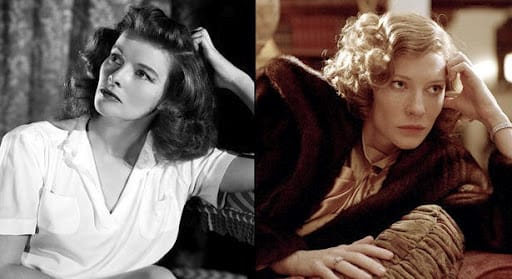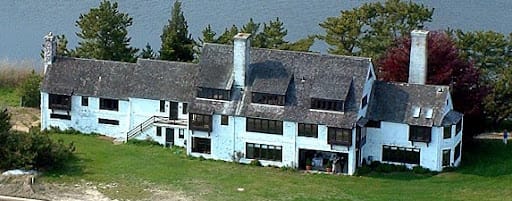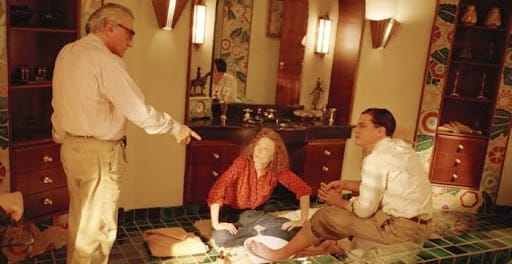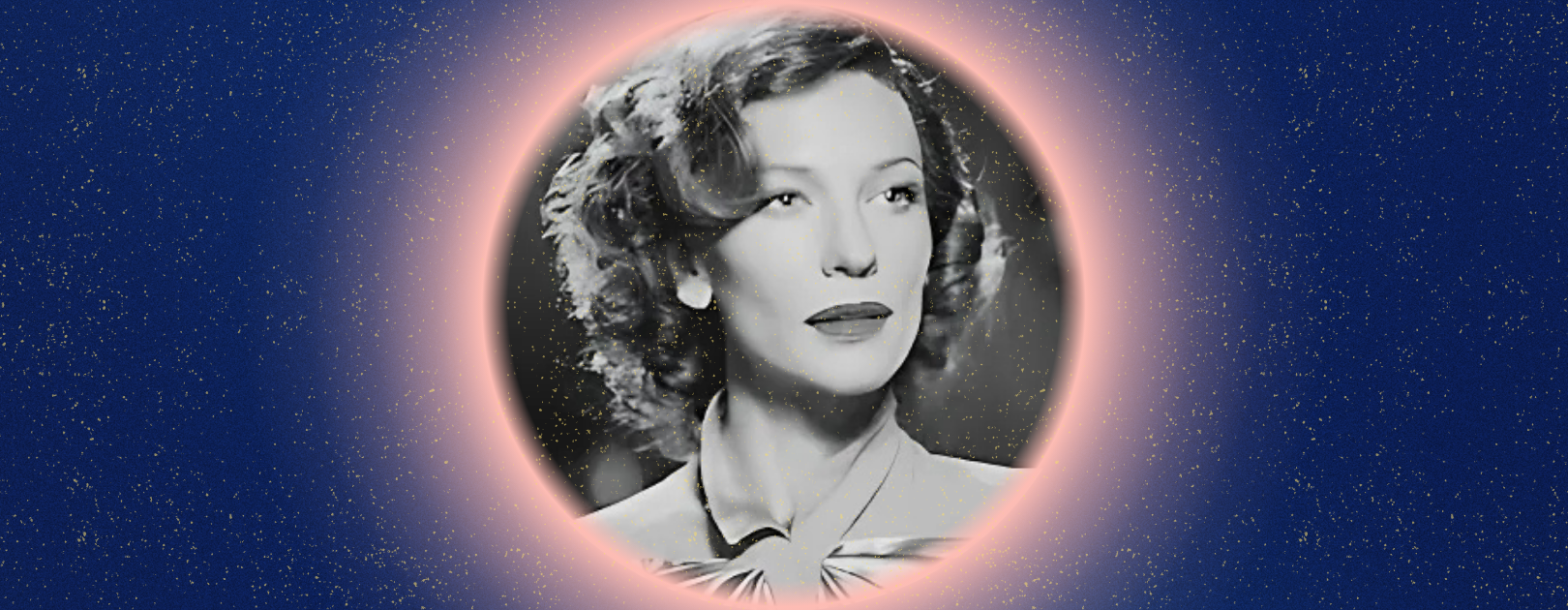Table of Contents
Blanchett's Oscar-winning Hepburn portrayal treads a fine line between research with caricature in Scorsese's Howard Hughes biopic, with mixed success.
In 2004, Martin Scorsese directed Leonardo DiCaprio as Howard Hughes in The Aviator, with Cate Blanchett co-starring as Katharine Hepburn, Hughes's long-term girlfriend in the 1930s. Blanchett's performance earned her the Academy Award for Best Supporting Actress, making her the first actor to win an Oscar for portraying a previous Oscar winner. This analysis examines Blanchett's embodiment of Hepburn through costume, voice, and physicality, whilst evaluating the film's historical accuracy in depicting the Hughes-Hepburn relationship.

I would like to start by saying that I enjoyed watching The Aviator. I really respect Scorsese‘s love of all things classic Hollywood and the way he incorporates themes and genres from old films in his work (i.e. Hugo (2011)). Leonardo DiCaprio has never thrilled me, even back when I was introduced to him in Titanic (1997) and all the other 3rd-graders were swooning over him. He picks really good, thought-provoking texts, but as an actor he seems very "Meryl Streep".
My other, and final, criticism of The Aviator is that Hughes is always so angry. I think writers/actors/directors do this to increase tension, but it just seems cheap and unrealistic to have him storming all over the place shouting at people. But maybe that’s just me. So, on to Cate Blanchett.
Preparation and physical transformation
Blanchett's commitment to authenticity involved watching Hepburn's first fifteen films and adopting the star's habit of taking cold showers. Working diligently with a speech coach, she mastered Hepburn's distinctive mid-Atlantic Bryn Mawr accent. The production team's attention to detail extended to remembering Hepburn's red hair, often misrepresented due to black-and-white photography. Early cartoons, caricatures and press interviews consistently reference her ginger locks and freckles. In The Philadelphia Story (1940), Cary Grant's character repeatedly calls Tracy "Red", confirming this often-overlooked physical characteristic.
Three different wigs were used to capture Hepburn's evolving hairstyles throughout the depicted period. Makeup artists applied freckles to Blanchett's face, arms, and chest, recreating what one contemporary described as Hepburn's "eternally sunburnt" appearance. Blanchett's naturally high cheekbones proved ideal for embodying Hepburn, whose bone structure was famously described as "the finest calcium deposits this side of Dover".

Costume design and star image
Sandy Powell's costume design brilliantly captured Hepburn's revolutionary fashion sense. The high-waisted, baggy trousers, loose-fitting blouses and dramatic formal gowns that defined Hepburn's public image appear throughout the film with meticulous attention to period detail. Powell's work reinforces how Hepburn's clothing choices challenged 1930s gender norms whilst establishing her as a fashion icon whose influence extended far beyond her film roles.
Performance analysis: Beyond imitation
Blanchett's portrayal transcends mere mimicry through her understanding of Hepburn's essential contradictions. She captures the forceful hand gestures and jaunty walk whilst embodying what I term the "Hepburn paradox": the simultaneous projection of strength and vulnerability, feminist independence and romantic yearning that defined Hepburn's star persona.
However, the screenplay occasionally pushes Blanchett towards caricature, particularly in scenes where Hepburn's dialogue becomes excessive prattling. This cartoonish representation shows the pitfalls of conflating Katharine Hepburn the person with Katharine Hepburn’s star persona.
Scene analysis: Historical accuracy and dramatic interpretation
The meeting: Fact versus Hollywood romance
The film depicts Hughes and Hepburn's first meeting during the filming of George Cukor's Sylvia Scarlett (1935). Whilst Hughes did arrange their introduction through mutual friend Cary Grant and made his dramatic airplane landing near the set, Hepburn's actual response differed markedly from the film's portrayal:
"I was somewhat taken aback because I had heard it rumoured that Hughes would like to meet me. And apparently this was how he'd figured it out. I gave Cary a black look and we all had lunch. I never looked at Howard. What a nerve!" (Hepburn, Me: Stories of My Life)
The film simplifies this dynamic, showing Hepburn smiling receptively as Hughes approaches her on the beach. This scene establishes a troubling pattern throughout their scenes together: Hepburn appears primarily as Hughes's girlfriend rather than an independent figure navigating a complex relationship. Whilst this perspective suits a Hughes-centric narrative, it diminishes Hepburn's agency.
The golf course: Performance choices and characterisation
Blanchett's golf course scene demonstrates both the strengths and weaknesses of her interpretation. Here, Blanchett's performance veers into caricature. Her twitchy energy and forced laughter (distinctly reminiscent of her Susan Vance in Bringing Up Baby rather than Hepburn's natural laugh) create an awkward dynamic that undermines believability. The scene's prattling dialogue forces Blanchett into an overwhelming presence that makes the Hughes-Hepburn pairing seem implausible rather than complex.
Dinner at Fenwick: Family dynamics and class misconceptions
The Fenwick dinner scene presents both fascinating insights and significant inaccuracies. The inclusion of Hepburn's ex-husband Ludlow Ogden Smith (Luddy) reflects careful research, as he remained close to the family despite the divorce. Dr Hepburn's famous remark about Luddy's photography is rendered accurately: "Howard, Luddy had been taking pictures of all of us for many years before you joined us and he will be taking them long after you've left."

However, several key inaccuracies undermine the scene's authenticity:
The estate misconception: The subtitle identifies Fenwick as "The Hepburn Estate", yet the Hepburns owned a beach house, not an estate. During the 1930s, this was still a modest wooden structure, not the larger brick house built after the 1938 hurricane.
Mrs Hepburn's characterisation: The film incorrectly gives her red hair (she was brunette) and portrays her as a fluttery bully. In reality, she was a Bryn Mawr-educated political activist who had spent years fighting for women's suffrage and birth control rights. As a First Wave Progressive Reform feminist, she was a personable, charismatic organiser, not the snobbish prude portrayed in The Aviator.
Class dynamics: The film's most egregious error involves its portrayal of the Hepburns as moneyed elites who "don't care about money". This fundamentally misunderstands their background. Dr Hepburn grew up in impoverished post-Civil War Virginia as a minister's son. Mrs. Hepburn was orphaned at sixteen, dependent on unsympathetic relatives. Both worked their way through university. They represented educated professionals, not inherited wealth.
The screenplay confuses Hepburn's star persona with her actual background. She was no Tracy Lord from The Philadelphia Story; she was the daughter of an upper-middle-class professional family who valued education and social reform over material wealth.
Despite these inaccuracies, the scene correctly captures the family's antipathy towards Hughes. As Hepburn later acknowledged:
"My family were not too sympathetic to Howard. In the first place, he was everlastingly on the telephone... Long telephone conversations did not suit the atmosphere."
The relationship's end: Strength and vulnerability
The break-up scene showcases Blanchett at her finest. She embodies Hepburn's strength of character without wavering when Hughes becomes upset, maintaining dignity whilst he responds immaturely. This scene best captures the Hepburn paradox of her special combination of strength and vulnerability that defined her star image.
The previous scene's vague depiction of Hepburn meeting Spencer Tracy lacks clarity and context. Given the well-documented nature of the Hepburn-Tracy meeting and relationship, this ambiguity seems an odd directorial choice. I didn't have a clue who it was supposed to be until several scenes later: a.) because you couldn’t see who it was, nor were there any other defining features and b.) we know how/when Hepburn and Tracy met and hooked up based on numerous interviews and documentaries Hepburn has made on the subject. So, I thought that was a bit strange.
Additional scenes and character insights
Several smaller scenes provide valuable character insights. When Hughes returns home injured after breaking the speed record, Hepburn's enthusiasm and caregiving response illuminates an often-overlooked aspect of her personality. Raised in a family committed to social service, Hepburn consistently demonstrated deep care for others throughout her life. She later took five years away from filmmaking to care for the ailing Spencer Tracy, demonstrating the caregiving nature this scene captures.

The nightclub escape scene, where Hepburn and Hughes abandon Hollywood society to go flying, rings true to Hepburn's character, though her presence at the club itself seems unlikely given her well-documented aversion to Hollywood social life.
Performance evaluation: Brilliance constrained by script
Cate Blanchett's portrayal of Katharine Hepburn makes a fascinating study of biographical performance. Her mastery of voice, gesture, and physicality creates an uncanny embodiment that earned deserved recognition. She successfully navigates the complex terrain between Hepburn's public persona and private self, suggesting deep research and thoughtful interpretation.
The performance's weaknesses stem primarily from John Logan's screenplay, which occasionally reduces Hepburn to a collection of mannerisms gathered from her film performances rather than a fully realised character. The dialogue often emphasises Hepburn's eccentricities at the expense of her intelligence and groundedness. The film's focus on glamorous Hollywood stardom overlooks the practical, press-dodging Bryn Mawr graduate who preferred Connecticut to California.
Historical accuracy: Person versus persona
The Aviator demonstrates both careful research and fundamental misunderstandings about Katharine Hepburn. The production team clearly studied photographs, films and biographical materials. Yet they consistently conflate Hepburn's screen persona with her actual life, presenting her as the aristocratic characters she often played rather than the doctor's daughter she was.
This confusion extends beyond simple facts to a broader characterisation. Due to the subject matter of the film, Hepburn is seen solely through her relationship to Hughes, reducing her complex negotiations of stardom, independence and romance to girlfriend status. Whilst any Hughes biopic must necessarily centre his perspective, the film misses opportunities to suggest Hepburn's own agency and ambitions.
Future biographical films might learn from both The Aviator's successes and limitations: the importance of distinguishing between public image and private reality, the need to grant historical figures their full complexity, and the value of allowing great performances room to breathe beyond the constraints of conventional biopic formulae.
Join the conversation
Share your perspectives below, especially if you've spotted details I've missed about the costume design, accent work, or historical inaccuracies.





